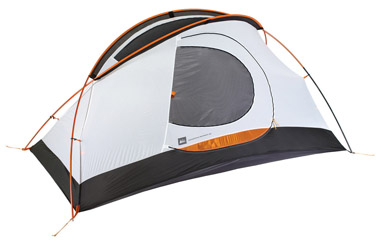There is a soft place in my heart for REI tents. As a burgeoning backpacker in the early ’90s, I bought an REI tent on sale for about $150 and kept it for years, staking the two-person shelter out on dozens of trips around the country.
This winter, I tested a small backpacking tent from the company (www.rei.com) that reminded me of that original shelter. The REI Cirque ASL 2 is built for three-season use — spring, summer, fall — plus “light winter weather,” according to the company.
Made for two people, the Cirque ASL 2 costs $269 — not as cheap as my first tent years ago, but still a value. The tent, a two-pole design, sets up quickly and provides the bare bones essentials expected in a backpacking model plus dual doors and vestibules for stowing packs and gear.

REI Cirque ASL 2 Tent
For transport, the tent stuffs down into a small cylindrical package that weighs a bit under 6 pounds (5 pounds, 11 ounces, as per REI’s specs). On a backpacking trip, you can split the weight — one person carries the tent, the other the stakes and poles — and have a minimal haul on the trail but still a substantial shelter to share when you get to camp.
Don’t except to comfortably hang out for long periods inside the Cirque ASL. You’re not going to want to play checkers in there. The tent is made mainly for sleeping, and it is cozy with an 88 × 56-inch floor and a peak height of 40 inches.
Two people sleeping in this tent will take up almost all the available space. On my recent trip with bulky winter sleeping bags, a friend and I filled its capacity width-wise in the shoulder area.
It snowed six inches one night on my trip. The heavy white stuff accumulated on the roof of this tent, darkening the interior and sliding off in a mini avalanche when I sat up and punched the nylon.

REI Cirque ASL 2 Tent with fly
Indeed, the Cirque ASL has a fairly flat roof, allowing snow to pile on. But the tent didn’t leak a drop, despite a wet and gloppy snowfall.
It wasn’t a big issue on my trip, but the zippers on this tent’s doors may be a concern for long-term durability. The large C-shape doors swoop open and close on a small-tooth zipper. But staked out with the walls pulled taut, there is a lot of pressure on these zippers. At one point, I had to tug on the side wall to get the zipper to scoot around a bend. This kind of built-in wear and tear makes me nervous.
On the upside, the tent has great ventilation — camper-induced condensation, an issue on some tents, was not a problem. Further, REI built special vents for wind coming across the tent’s outer face that are touted to direct airflow and actually increase the structural strength of the tent in a gust.
Overall, the Cirque ASL performed fine on my recent trip in the snow. It was an ease to haul in and setup, and the space inside was adequate for sleeping at the end of each hard day.
There are design tweaks I would recommend, especially with the door zippers. I was not immediately as chummy with the Cirque ASL as my old REI standby shelter from years back. But this was my first trip with the Cirque. The first of hopefully many more adventures to come.
—Stephen Regenold writes a daily blog on outdoors gear at www.gearjunkie.com.






